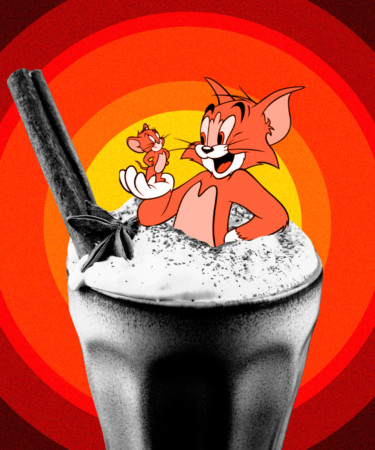When you’re craving a hot, lightly spiced, and creamy drink during the holidays, odds are you’re reaching for eggnog. But sometimes, eggnog just doesn’t cut it: The stuff from the store can taste like preservatives, and no sane person can commit three hours of standing over the stove for the good homemade stuff.
It’s time to get reintroduced to the Tom and Jerry, a long forgotten holiday drink that has lived on in the cold and blustery Midwest.
This velvety and lush delight is composed of two parts: batter and booze. The batter is made by whipping egg whites into a soft-peaked meringue — dollop-worthy while maintaining some structure — and then adding egg yolks and holiday spices like cinnamon and allspice. Or, if you’re in a bit of time crunch, store-bought batter works just fine.
Separately, combine brandy, rum, and warmed milk. When ready to drink, pour the batter into a mug, top with the boozy mixture, and stir to combine. What comes next is just pure glee and giddy — like drinking a hot, freshly baked sugar cookie.
While the drink’s origins are largely unknown, most reference 19th-century British author Pierce Eagan as the drink’s inventor — creating the cocktail as an elaborate PR stunt to help promote his book “Life in London.” While this story may be nothing more than a drinking myth, Egan’s book and subsequent play did contribute to drinking culture, introducing the phrase “Tom and Jerrying” to mean partaking in rambunctious, drunken behavior.
Another story suggests that the Tom and Jerry was created in the 1850s by famed New York bartender and showman Jerry Thomas — a man known for spiking drinks with blue fire. Cocktail historian David Wondrich claims that while Thomas popularized the drink as a Christmas essential, the drink’s popularity inevitably died off in the 1960s due to America’s obsession with convenience — thus turning consumers toward eggnog, the more shelf-stable grocery store option.
But to this day, for some unknown reason, the Tom and Jerry remains popular in the Upper Midwest. Wisconsin-based historian Jim Draeger attributes this to Wisconsin’s affinity for brandy and dairy — and the fact that the region is so cold, its residents need as many winter warmers as they can get. In thrift stores across the area, collectors can find kitschy antique milk glass mugs printed with red, green, and gold lettering, advertising Tom and Jerry batter.
